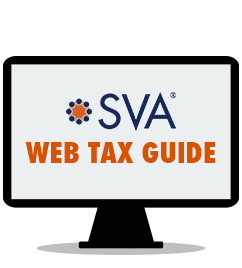Taxes can be a complicated subject. SVA has business professionals covered with easy access to the information they need to make informed decisions. Explore education expense strategies, tax strategies, and tax debt resolution information below and contact SVA for more information on how we may be able to help with your tax needs.
We’ve compiled everything you need to know about the new tax law.
Business professionals need easy access to information to make timely decisions. SVA has what you need, when you need it. Choose a topic below or just contact us directly. Our expertise is ready anytime you need it.
Planning for current and future education expenses is especially important. Several tax incentives can help reduce the cost of paying for higher education.
These incentives include the American Opportunity Tax Credit, Lifetime Learning Credit, Qualified Tuition Programs, Student Loan Interest Deduction, 529 Plans, and the Coverdell Education Savings Account.
The incentives can be a credit deduction or exclusion and may be limited by income.
The more you pay in taxes, the less money you have to invest in your personal financial goals. The key to reducing your tax liability rests in proactive planning.
We can identify and implement key planning opportunities to minimize your current tax liability. Reach out to our experienced tax professionals who can look at your overall tax situation and help you understand and reduce your tax impact.
We can help you with:
Being delinquent in your tax payments can result in a vast array of problems and cause substantial amounts of undue stress. Our qualified professionals can work with you in dealing with the IRS and other taxing authorities on delinquent tax liability, tax penalty, and interest issues, as well as challenges in your ability to pay the amount due. Offer in Compromise (OIC), bankruptcy, and negotiated payment schedules are a few of the strategies we can utilize in helping you deal with delinquent and disputed tax issues.

Visit SVA’s Web Tax Guide to access a wide array of resources that can help prepare you and your business for the upcoming tax season.
Download the 2025 Federal Tax Rates PDF to get all the 2025 tax rates.
Services
Madison, WI
1221 John Q Hammons Dr, Suite 100
Madison, WI 53717
(608) 831-8181
Milwaukee, WI
18650 W. Corporate Drive, Suite 200
Brookfield, WI 53045
(262) 641-6888
Colorado Springs, CO
10855 Hidden Pool Heights, Suite 340
Colorado Springs, CO 80908
(719) 413-5551

Are you in the know on the latest business trends, tips, strategies, and tax implications? SVA’s Biz Tips are quick reads on timely information sent to you as soon as they are published.
Copyright © 2025 SVA Certified Public Accountants | Privacy Policy | Cookie Policy | CCPA